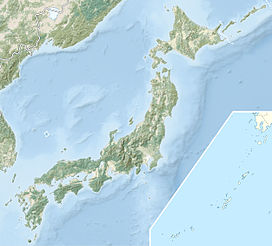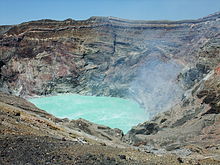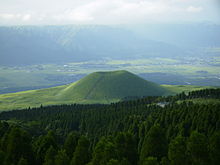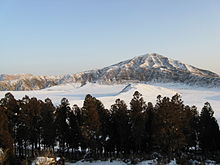- Mount Aso
-
Mount Aso 阿蘇山 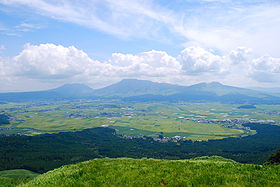
Central cone group of Aso calderaElevation 1,592 m (5,223 ft) Location Kyūshū, Japan Coordinates 32°53′04″N 131°06′14″E / 32.88444°N 131.10389°ECoordinates: 32°53′04″N 131°06′14″E / 32.88444°N 131.10389°E Geology Type Caldera complex Last eruption 2011 Mount Aso (阿蘇山 Aso-san) is the largest active volcano in Japan, and is among the largest in the world. It stands in Aso Kujū National Park in Kumamoto Prefecture, on the island of Kyūshū. Its peak is 1592 m above sea level. Aso has one of the largest caldera in the world (25 km north-south and 18 km east-west).[1] The caldera has a circumference of around 120 km (75 mi), although sources vary on the exact distance.
Contents
Geology
The central cone group of Aso consists of five peaks: Mt. Neko, Mt. Taka, Mt. Naka, Mt. Eboshi, and Mt. Kishima. The highest point is the summit of Mt. Taka, at 1592 m above sea level. The crater of Mt. Naka, the west side of which is accessible by road, contains an active volcano which continuously emits smoke and has occasional eruptions. Only the northernmost crater (the first crater) has been active for the last 70 years—1974, 1979, 1984–1985, 1989-1991,[1] 2009, and 2011.[2]
The present Aso caldera formed as a result of four huge caldera eruptions occurring over a range of 90,000–300,000 years ago. The caldera, one of the largest in the world, contains the city of Aso as well as Aso Takamori-cho and South Aso-mura. The somma enclosing the caldera extends about 18 km east to west and about 25 km north to south. Viewpoints from the somma overlooking the caldera are perched upon lava formed before the volcanic activity which created the present caldera.
Ejecta from the huge caldera eruption 90,800 years ago covers more than 600 km³ and roughly equals the volume of Mt. Fuji; it is presumed that the pyroclastic flow plateau covered half of Kyūshū.
History
The eruption which formed the present somma occurred approximately 300,000 years ago.
Four large-scale eruptions (Aso 1 – 4) occurred during a period extending from 300,000 to 90,000 years ago. As large amounts of pyroclastic flow and volcanic ash were emitted from the volcanic chamber, a huge depression (caldera) was formed as the chamber collapsed. The fourth eruption (Aso 4) was the largest, with volcanic ash covering the entire Kyūshū region and even extending to Yamaguchi Prefecture.
Mt. Taka, Mt. Naka, Mt. Eboshi, and Mt. Kishima are cones formed following the fourth above-mentioned huge caldera eruption. Mt. Naka remains active today. It is presumed that Mt. Neko is older than the fourth huge caldera eruption.
Aso's pyroclastic flow deposits (welded tuff) were utilized for bridge construction in the region. There are approximately 320 arched stone bridges in Kumamoto Prefecture, including the Tsujun-kyo and Reidai-kyo bridges on Midorikawa River, which are important national cultural properties.[1]
See also
- List of volcanoes in Japan
- Aso Shrine
- Mount Aso Ropeway
- Aso Volcano Museum
References
- "Aso". Global Volcanism Program, Smithsonian Institution. http://www.volcano.si.edu/world/volcano.cfm?vnum=0802-11=.
External links
- Google Maps - Mt. Aso by satellite photography
- New York Public Library Digital Gallery, early photograph of smoke plume from Mt. Aso
- Mount Aso - A Small Town Inside the Crater
Categories:- Volcanoes of Kyūshū
- VEI-7 volcanoes
- Active volcanoes
- Subduction volcanoes
- Volcanic calderas of Japan
- Mountains of Kumamoto Prefecture
- Complex volcanoes
- Visitor attractions in Kumamoto Prefecture
Wikimedia Foundation. 2010.

